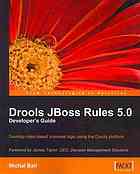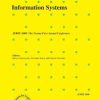Drools JBoss Rules 5 0 Developers Guide 1st Edition by Michal Bali, James Taylor, Sammy Larbi ISBN 8184048408 978-8184048407
$50.00 Original price was: $50.00.$35.00Current price is: $35.00.
Drools JBoss Rules 5 0 Developers Guide 1st Edition by Michal Bali, James Taylor, Sammy Larbi- Ebook PDF Instant Download/Delivery:8184048408, 978-8184048407
Full download Drools JBoss Rules 5 0 Developers Guide 1st Edition after payment

Product details:
ISBN 10: 8184048408
ISBN 13: 978-8184048407
Author: Michal Bali, James Taylor, Sammy Larbi
Develop rules-based business logic using the Drools platform
- Discover the power of Drools as a platform for developing business rules
- Build a custom engine to provide real-time capability and reduce the complexity in implementing rules
- Explore Drools modules such as Drools Expert, Drools Fusion, and Drools Flow, which adds event processing capabilities to the platform
- Execute intelligent business logic with ease using JBoss/Drools, a stronger business-rules solution
- Covers examples of a fraud detection system utilizing Drools CEP (Complex Event Processing) capabilities
In Detail
Business rules can help your business by providing a level of agility and flexibility. As a developer, you will be largely responsible for implementing these business rules effectively, but implementing them systematically can often be difficult due to their complexity. Drools, or JBoss Rules, makes the process of implementing these rules quicker and handles the complexity, making your life a lot easier!
This book guides you through all of the features of Drools, such as dynamic rules, the event model, and Rete implementation with high performance indexing. It will help you to set up the JBoss Rules platform and start creating your own business. It’s easy to start developing with Drools if you follow its real-world examples that are intended to make your life easier.
Starting with an introduction to the basic syntax that is essential for writing rules, the book will guide you through validation and human-readable rules that define, maintain, and support your business agility. As a developer, you will be expected to represent policies, procedures and. constraints regarding how an enterprise conducts its business; this book makes it easier by showing you it can be done.
A real-life example of a banking domain allows you to see how the internal workings of the rules engine operate. A loan approval process example shows the use of the Drools Flow module. Parts of a banking fraud detection system are implemented with Drools Fusion module, which is the Complex Event Processing part of Drools. This in turn, will help developers to work on preventing fraudulent users from accessing systems in an illegal way.
Finally, more technical details are shown on the inner workings of Drools, the implementation of the ReteOO algorithm, indexing, node sharing, and partitioning.
What you will learn from this book?
- Write more efficient business rules, and work with the Rete algorithm, node indexing, node sharing, and parallelization
- Create a WS-HumanTask-compliant WorkItem in a process (workflow)
- Implement concurrency control in cross-cutting functionalities to manage code easily
- Write human-readable rules, and Domain Specific Language for your rules to easily understand and verify them
- Generate a stateful service by using a stateful knowledge session that maintains state between invocations and teaches you how to transactionally persist this service
- Develop dynamic remote knowledge-base loading to change rules in your application without even stopping it
- Prepare decision tables for calculating account interest rates
- Integrate Drools within your Java business application, and integrate it with the Spring framework
Approach
This is a problem-solution guide that starts with an introduction to a problem and continues with a discussion of the possible solution. The book covers best practices when working with Drools. The examples and their solutions are accompanied by plenty of code listings and figures providing a better view of the problem.
Table of contents:
Chapter 1: Introduction
Problems with traditional approaches
The solution
Advantages
Disadvantages
When not to use a rule engine
Drools
Alternatives to Drools
Summary
Chapter 2: Basic Rules
Rule basics
Executing rules
Rule syntax
Rule concepts
Variables in rules
Types
Comments
Package
Imports
Global variables
Functions
Dialect
Rule condition
And
Or
Not
Exists
Eval
Return value restriction
Inline eval
This
Working with collections
Rule consequence
Rule attributes
Salience (priority)
No-loop
Dialect
Summary
Chapter 3: Validation
Banking domain model
Problem definition
Analysis
Design
Validation package
Object required type rules
Testing
Minimal account balance rule
Student account rule
Unique account number rule
Implementation
Validation service
Summary
Chapter 4: Data Transformation
Process overview
Getting the data
Loading facts into the knowledge session
Writing transformation rules
Testing
Address normalization
Testing the findAddress rule
Unknown country
Currency conversion
One account allowed
Transformation results
Implementation of the data loading
Database setup
Project setup
iBatis configuration
Running iBatis
Alternative data loading
Summary
Chapter 5: Human-readable Rules
Domain Specific Language
DSL as an interface
DSL for validation rules
File formats
DSL file format
DRL file format
DSLR file format
DSL for multiple constraints in a condition
Named capture groups
DSL for data transformation rules
Decision tables
Advantages of a decision table
Disadvantages of a decision table
Calculating the interest rate
Project setup
Testing
Comma Separated values
Rule Templates
Drools Flow
Drools Agenda
Methods for managing rule execution order
Ruleflow
Start
End
Action
RuleFlowGroup
Split
Join
Example
Rules
KnowledgeBase setup
Tests
People also search for:
drools javadoc
drools java 11
drools guide
drools java 17
drools book pdf
Tags:
Michal Bali,James Taylor,Sammy Larbi,developer



